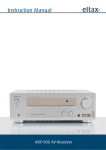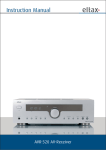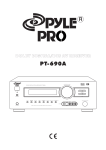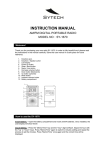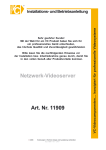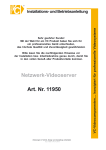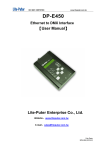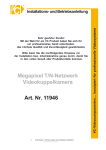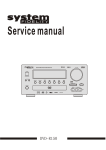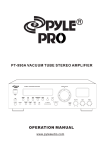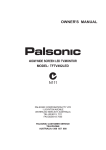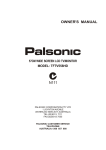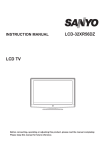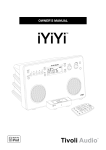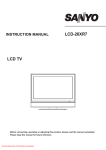Download User manual
Transcript
MCS-600 Instruction manual The objective of every Tangent product is that fundamentally correct design can produce a product capable of achieving excellent performance and affordability. www.tangent-audio.com This operation manual supplies all the information that you need to have about your Tangent MCS-600. Please read this operation manual carefully before you start using the unit! 02 CONTENTS Safety precautions Important safety instructions Important information Connection to the mains Front and rear panel functions Front panel functions Rear panel functions Remote control Installation of batteries Using the remote control Remote control functions Connections Connection of speakers Rear panel connections Front panel connections Using the radio Connecting an antenna Tuning in channels RDS (Radio Data System) Back-up memory Troubleshooting guide Specifications 4 5 7 8 9 9 10 11 11 11 12 14 14 15 15 16 16 16 17 17 18 19 03 SAFETY PRECAUTIONS A triangle with a lightning symbol draws the user's attention to "dangerous voltage" without insulation in the cabinet which may be high enough to entail a risk of electric shock. A triangle with an exclamation mark draws the user's attention to important instructions for use and maintenance in the enclosed manual, which should be studied. A symbol for CLASS II (double insulation) WARNING: TO MINIMISE THE RISK OF FIRE OR ELECTRICAL SHOCK, DO NOT EXPOSE THE UNIT TO RAIN OR MOISTURE. DO NOT OPEN THE CABINET AS IT CONTAINS DANGEROUS VOLTAGE. ONLY QUALIFIED TECHNICIANS ARE ALLOWED TO CARRY OUT REPAIR AND SERVICE. CAUTION: If the plug of the power cord needs to be replaced, it is important that the replacement is identical to the plug to be replaced, or that the new plug has been recommended by the manufacturer TO AVOID ELECTRICAL SHOCK, IT IS IMPORTANT TO INSERT THE PLUG CORRECTLY INTO THE SOCKET. The marking of products using lasers (except for some areas). The label is attached to the rear panel and says that the component uses beams that have been classified as Class 1, which means the unit is utilizing laser beams that are of weaker class. There is no danger of hazardous radiation outside the unit. 04 IMPORTANT SAFETY INSTRUCTIONS WARNING: IT IS IMPORTANT THAT YOU READ AND OBSERVE BOTH THE INSTRUCTIONS IN THIS MANUAL AND THE INSTRUCTIONS ON THE UNIT. KEEP THIS MANUAL FOR FUTURE REFERENCE. This unit was designed and manufactured with a view to providing maximum safety for the user. Incorrect use of the unit may cause electrical shock or fire. The protection devices built into this unit will protect the user if the procedures below are observed in connection with installation, use and repair. This unit is fully electronic and contains no parts that can be repaired by the user. DO NOT REMOVE THE CABINET. RISK OF DANGEROUS VOLTAGE. ONLY QUALIFIED TECHNICIANS ARE ALLOWED TO REPAIR THE UNIT. Read the manual Heat Upon unpacking the unit, please read the manual carefully and observe all the instructions given. Do not place the unit near sources of heat such as radiators, heat registers, ovens or other units that produce heat. Water and moisture Power supply The unit must not be placed close to water, such as bathtub, wash basin, kitchen sink or laundry tub, in a damp cellar or close to a swimming pool, etc. Only the power supply indicated on the rating plate must be used for this unit. If you are not sure which power supply you have, please contact the distributor or the local electricity supplier. Cleaning Unplug the unit before cleaning. Do not use liquid detergents and aerosol cleaning agents. Use a dry cloth. Earthing or polarisation If the plug cannot be inserted properly into the socket, or if the plug does not fit, the unit must not be used in your country. Power cords Wiring must be organised to prevent people from stepping on the cables and to avoid pinching by objects placed on or beside them. Take special care around sockets and plug boxes and where the power cords leave the unit. Ventilation The cabinet is provided with slots and openings to ensure ventilation and reliable operation and to protect the unit against overheating. Do not block or cover these openings. The openings must never be blocked, for instance by placing the unit on a bed, a sofa, a carpet or similar surface. Overloading Make sure that wall sockets, extension cords and plug boxes are not overloaded as this may lead to fire or electrical shock. 05 IMPORTANT SAFETY INSTRUCTIONS Lightning Damage Unplug the unit for additional protection during thunder or when the unit is not used for prolonged periods. This will prevent damage to the unit from lightning and power surges. Unplug the unit and contact qualified technicians in the following cases: A) If the power cord or the plug is damaged. B) If liquid has been spilled on the unit or objects have fallen into the unit. C) If the unit has been exposed to rain or water. D) If the unit does not work properly after adhering to the instructions in the operation manual. Only the settings described in the operation manual must be made as incorrect setting may result in damage and often will make it difficult for a qualified technician to make the unit work properly again. E) If the unit has been dropped or damaged in any other way. F) When the operation of the unit changes drastically, the unit requires service. Penetration of objects and liquid Never push any foreign objects through the openings into the unit, as they may touch dangerous voltage points or shortcircuit parts and thus cause fire or electric shock. Do not spill liquid on the unit. Accessories Service Do not place the unit on unstable surfaces such as a trolley, stand, tripod, shelf or table. The unit may fall and injure children or adults or be seriously damaged. Use only trolley, stand, tripod, shelf or table that is very stable or provided with the unit. The unit must be installed in accordance with the manufacturer's instructions and by means of installation equipment recommended by the manufacturer. If the unit is placed on a trolley, the trolley must be moved very carefully. Sudden stops, unnecessary force and uneven surfaces may cause the trolley to turn over. Do not attempt to carry out any service work yourself. By opening or removing the cabinet, you will be exposed to dangerous voltage or other hazards. Any service work should be carried out by qualified technicians. Spare parts If spare parts are required, make sure that the service technician uses spare parts specified by the manufacturer or spare parts with the same characteristics as the original. Unauthorised spare parts may cause fire, electrical shock, etc. Loads Do not place heavy loads on the unit and do not step on it. The load may fall and cause serious injury to persons or damage to the unit. Safety check After service or repairs on the unit, ask the service technician to carry out a safety check to ensure that the unit is ready for use. 06 IMPORTANT INFORMATION Handling instructions Condensation - The top and back panel of the unit may become warm after prolonged use. This is not due to a defect. - Turn off the power when the unit is not used. Condensation may occur in the following cases: - When the unit is moved directly from a cold to a warm place. - When the unit is used in a room where the radiator has just been switched on or a place where the cold air from the airconditioning system is directed at the unit. Protect the power cord - If the unit is used in the summer in a warm and humid room just after it has been moved from an air-conditioned room. - Follow the instructions below to prevent abnormal operation, electrical shock, fire or personal injury: - Hold the plug firmly when inserting it into the socket. - Avoid heat-producing devices. - Do not place objects on the power cord. - Do not carry out service work on or change the power cord. - If there is steam or a high level of humidity in the room. In case of condensation, the unit will not work properly. Turn off the unit. Unplug the unit and leave it for 2-3 hours. The unit will then have adapted to the environment and any condensation will have disappeared. Positioning Do not place the unit in any of the fol. places: - In sunlight, close to heat-producing devices or in an enclosed rack. - In places with high temperatures (40C or more) or high relative humidity (90% or more). - In dirty places as some internal parts may be damaged. Do not put your fingers or any other objects into the unit - Touching the internal parts is dangerous and may cause injury or damage. Do not open the cabinet. - Do not place any foreign matter in the unit. Interference Placing the unit near a television set, radio or video player may cause poor picture and sound quality. In that case, move the unit further away from the television set, radio or video player. 07 CONNECTION TO THE MAINS Connection to the mains ON POWER Model: MCS-600 Power rating: AC 220V - 240V~50Hz Max Power Consumption:120W OFF CLASS 1 LASER PROCUCT ANTENNA SPEAKER 6-8OHM RIGHT LEFT FM 75W AUDIO L AM LOOP R 220-240V ~50Hz SUB LINE OUT REC OUT TAPE IN AUX 1 IN DVD IN Do not turn on the power before all connections have been made correctly. Check that all connections have been made correctly before turning on the power. Check that the mains voltage is 220-240V AC50~60Hz before turning on the power. (US version 110-130V AC50~60Hz) Connection to the mains Check that all other connections have been made correctly before inserting the mains plug into the wall socket. Then insert the plug into a suitable socket. If the unit is to be used abroad, you may need an adapter. 08 FRONT AND REAR PANEL FUNCTIONS 1 4 3 2 VOLUME MCS-600 Mini CD System POWER STANDBY TUNING STATION SOURCE REPEAT PHONES LINE IN 5 6 7 8 9 10 11 12 13 14 15 AUX 2 16 Front panel functions The points below contains a brief description of the front panel buttons, inputs and outputs. For more detailed descriptions of the functions and connections, please see the following pages of the manual. 1. Standby LED The standby LED indicates wether the unit is on or in standby. When the receiver is on, the standby LED will glow green. When the receiver is in standby, the standby LED will glow red 2. Power Standby Press the power button to set the receiver into standby. The standby LED will turn red. Press the power button once again, to turn on the receiver on again. The standby LED will turn green. 3. VFD Display Shows information of the selected input source, adjustments and system state. 4. Master volume. Turn this button clockwise and counterclockwise to adjust the master volume. Turn the knob clockwise to increase the volume and counter clockwise to decrease the volume. 5. Tuning +/Press the + or / button to adjust up or down in frequency in radio mode. 6. Station Press this button to change between stored radio presets. 7. Source Press this button to select different kinds of source: CD, FM, AM, AUX1, TAPE, DVD, LINE IN, AUX2 8. Repeat Press this button to activate repeat playback. Press it repeatedly to change between REPEAT ONE, REPEAT ALL and REPEAT OFF. 9. Previous (I<<) PPress this button to skip to previous track in CD mode. 10. Next (>>I) Press this button to skip to next track in CD mode. 11. Play/Pause Press this button if you want to start or interrupt the disc playing 12. Open/Close/Stop In CD mode, press this button if you want to stop the disc playing, press the button once more to open the disc tray. And once again to close the tray again 13. Phones This connecter is for connecting headphone. Adjust the volume so that it does not hurt your ears when using headphones. If you do not intend to use your headphones, always ensure that you unplug them. 14. Disc Tray 15. Line In Connect to a MP3 player or other audio device by using a Ø3.5mm jack line. 16. Aux 2 Connect to the audio line output terminals of an external source. 09 FRONT AND REAR PANEL FUNCTIONS Rear panel functions 1 ON POWER Model: MCS-600 Power rating: AC 220V - 240V~50Hz Max Power Consumption:120W OFF CLASS 1 LASER PROCUCT ANTENNA SPEAKER 6-8OHM RIGHT LEFT FM 75W AUDIO L AM LOOP R 220-240V ~50Hz 2 SUB LINE OUT 3 REC OUT TAPE IN AUX 1 IN DVD IN 4 5 6 7 8 9 10 The points below contains a brief description of the rear panel buttons, inputs and outputs. For more detailed descriptions of the functions and connections, please see the following pages of the manual. 1. Mains power switch. Mains power ON/OFF switch. This is not a standby function. This is the mains power switch. When this switch is set to OFF, the receiver will not use any power at all. Please notice that the stored radio presets and sound adjustments will be erased from the receiver when it is turned off on the powerswitch for a period longer than one week. 2. Mains power input. Connect the AC power cord to this jack when the installation is complete. To ensure safe operation, use only the power cord supplied with the receiver. If a replacement is required it must be of the same type and capacity. 3. Speaker output terminals. For connecting the speakers of the system. Note that the impedance of the connected speaker must be between 4 and 8 ohm. Please make sure that the power is disconnected from the receiver while making any speaker connection. 4. Subwoofer pre output. Connect an active subwoofer. 5. Record output Record outputs for a tape recorder. These outputs must be connecter in order to be able to record. Please notice that the tape output signal is an analog stereo record output tape recorders. 6. Tape input connection. Analog inputs for an analog tape recorder. 7. AUX1 input connection. Analog inputs for an auxiliary stereo source. 8. DVD input connection. Analog inputs for a DVD player or another analog stereo source. Please notice that the input signal must be an analog stereo signal. 9. AM antenna input. Connect the included AM loop antenna to this input or an external AM antenna. 10. FM antenna input. Connect the included FM antenna whip to this input or an external FM antenna. Make sure the cable used for this is a 75 ohms coaxial antenna cable. 10 REMOTE CONTROL Installation of batteries 1 Remove the battery cover as illustrated. 3 Replace the battery cover. 2 Position two batteries of the type AAA/R03/UM4 in the battery compartment. Make sure that the orientation of the batteries is correct (see drawing at bottom). - Do not mix new and old batteries and do not use different types of batteries. - If the remote control is not used for prolonged periods, remove the batteries from the remote control to avoid corrosion. Using the remote control Direct the remote control at the sensor on the front panel of the unit. When the remote control signal is received, the unit reacts accordingly. The remote control works within a range of 6 metres. VOLUME MCS-600 Mini CD System POWER STANDBY TUNING SOURCE STATION REPEAT PHONES LINE IN - Sometimes the remote control does not work well in strong light. You may have to move the unit if it is a problem. - Malfunction may occur if other remote controls are used near the unit. - Do not place any objects on the remote control, as the batteries may become flat if a key is depressed constantly. - Make sure that there are no obstacles between remote control and unit. - Do not position the unit behind tinted glass as it may reduce the maximum range of the remote control. POWER 1 5 3 2 4 6 7 9 0 10+ AUTO MEM APS CD DVD TUNER ST/MO AUX1 AUX2 TAPE LINE IN 8 PTY SEARCH STATION TUNING TUNING MUTE BASS STATION TREBLE BALANCE LOUDNESS DISPLAY REPEAT MCS-600 11 VOLUME AUX 2 REMOTE CONTROL Remote control functions POWER 18 1 1 2 3 4 5 6 7 8 9 0 10+ AUTO MEM APS PTY SEARCH CD DVD TUNER ST/MO AUX1 AUX2 TAPE LINE IN 2 19 3 4 5 6 7 8 20 21 22 23 24 25 STATION TUNING TUNING 26 MUTE 9 10 11 12 13 BASS STATION TREBLE BALANCE LOUDNESS DISPLAY REPEAT 14 15 16 17 VOLUME 27 28 29 30 31 32 MCS-600 1. Power Press the power button to set the receiver into standby. The standby LED will turn red. Press the power button once again, to turn on the receiver on again. The standby LED will turn green. 2. 0-9 Digits Use these buttons to select radio presets or CD tracks. 3. Memory Use this button to store a radio station to any given preset. 4. Auto Press this button to change between Auto search or step search during manual tuning on FM or AM. 5. DVD Press this button to select the DVD input on the rear panel. 6. CD Press this button to select the CD player as source. 7. AUX 2 Press this button to choose the analog stereo AUX2 input on the front panel. 8. AUX 1 Press this button to choose the analog stereo AUX1 input on the rear panel. 12 REMOTE CONTROL 9. Tuning and Station buttons Tuning +/-: Use this button to manually search up and down in frequency for radio stations. Station +/-: Press this button to select the previous or next stored preset in radio mode. 10. Treble Press this button to active the treble equalizer. Press the volume + and - buttons (29) to adjust. 11. Bass Press this button to active the bass equalizer. Press the volume + and - buttons (29) to adjust. 12. Display Press this button to change the information on the selected input source, adjustments and system state. 13. Loudness Press this buttopn to set the loudness function on and off. 14. Stop Press this button to stop CD playback 15. Pause Press this button to pause CD playback. Press the Play button (30) to start playback again. 16. Fast reverse Press this button to rewind CD playback. Press the Play button (30) to start playback again. 17. Previous Press this button to select the previous CD track. 18. Open/Close Press this button to open and close the CD tray in CD mode. 19. +10 Press this button and then one of the 0-9 digits to select a radio preset or CD track higher than 9. Ex.: Press the +10 button and then the 5 digit to select 15. 20. APS Auto Preset Search. Press this button and the unit will search and store all available presets on FM. 21. PTY Search Press the button once to activate the PTY search function. PTY search will flash in the display. Use the TUNING+/- button to select the genre you wish to search for. Press the PTY search button again, and the unit will find the PTY genre if available. 22. Tuner Press this button to choose the built in tuner. Press it again to change between FM and AM. 23. ST/Mo Use this button to change between Stereo and Mono on FM. 24. Tape Press this button to choose Tape input on the rear panel. 25. Line in Press this button to activate the 3.5mm stereo line input on the front panel. 26. Mute Press this button to mute all sound. Press it again to cancel the mute function. 27. Balance Press this button to adjust the volume individually for each channel. Press the volume + and - buttons (29) to adjust. 28. Repeat Press this button to activate REPEAT ONE during CD playback. Press it again to activate REPEAT ALL and once again turn deactivate the repeat function. 29. Volume + and - buttons For adjusting Master volume, Bass and Treble. 30. Play Press this button to start playback. 31. Fast Forward Press this button to fast forward CD playback. Press the Play button (30) to start playback again. 32. Next Press this button to select the next CD track. 16. Fast reverse Press this button to rewind CD playback. Press the Play button (30) to start playback again. 32. Previous Press this button to select the previous CD track. 13 CONNECTIONS Connecting speakers Right front Left front ON POWER Model: MCS-600 Power rating: AC 220V - 240V~50Hz Max Power Consumption:120W OFF CLASS 1 LASER PROCUCT ANTENNA SPEAKER 6-8OHM RIGHT LEFT FM 75W AUDIO L AM LOOP R 220-240V ~50Hz SUB LINE OUT REC OUT TAPE IN AUX 1 IN DVD IN Active subwoofer Before Connection Before connection turn off the power of all the equipment. Read instructions of each component you intend to connect to this unit. ! Prepare the speaker cords for connection by stripping off approximately 10 mm or less (no more as this could cause a short-circuit) of the outer insulation. Twist the wires tightly together so that they are not straggly. ! Be sure to insert each plug securely. To prevent hum and noise, do not bundle the interconnection leads with power cord or speaker leads. How to connect Colored: positive (+) Black: negative (-) Speaker Connections Caution: To avoid damaging the speakers with a sudden high-level signal, be sure to switch the power off before connecting the speakers. ! Check the impedance of your speakers. Connect speaker with an impedance between 4 and 8 ohms. The amplifier's colored speaker terminals are the + (positive) terminals and the black terminals are the (negative) terminals. ! The + side of the speaker cable is marked to make it distinguishable from the side of the cable. Connect this marked side to the colored + terminals and the unmarked side is the black terminal. 1. Unscrew the knob 2. Insert the speaker cable. 3. Tighten the knob and secure the cable. 14 CONNECTIONS ON POWER Model: MCS-600 Power rating: AC 220V - 240V~50Hz Max Power Consumption:120W OFF CLASS 1 LASER PROCUCT ANTENNA SPEAKER 6-8OHM RIGHT LEFT FM 75W AUDIO L AM LOOP R 220-240V ~50Hz SUB LINE OUT Tape player/recorder REC OUT TAPE IN AUX 1 IN DVD IN CD player DVD player Rear panel connections: The rear panel has three analog stereo inputs (TAPE, AUX1 and DVD) and one analog record output. Connect to source equipment using phono cables (stereo 2RCA-2RCA). Choose the source by pressing the button on the remote that fits the wanted input. Note: Do not plug in the mains power lead or turn on the unit all connections have been made. VOLUME MCS-600 Mini CD System POWER STANDBY TUNING STATION SOURCE REPEAT PHONES LINE IN AUX 2 MP3 player/ Cell phone CD player Front panel connections: The front panel has two analog stereo inputs (Line in and AUX2). These inputs are intented for temporary and easy connections. The line in is a Ø3.5mm stereo jeck input, made for easy connection of Cell phones, Mp3 players, etc. The AUX2 input is a standard 2 RCA input, that should be connected the same way as the inputs on the rear panel. Choose the source by pressing the button on the remote that fits the wanted input. Note: Do not plug in the mains power lead or turn on the unit all connections have been made. 15 USING THE RADIO Connecting an antenna POWER Before you can start listening to radio stations, you must connect an antenna to the MCS-600. The receiver is able to receive both FM and AM radio. It is therefore possible to connect both an AM and a FM antenna to the receiver. AUTO AUTO 1. FM antenna input. Connect the included FM antenna whip to this input. Adjust the position of the antenna whip until optimum reception is achieved. If an satisfying signal cannot be received with the included antenna whip, an external FM antenna must be connected instead. Make sure the cable used for this is 75 ohms coaxial antenna cable. The input can also be used for connection to an antenna cable network if available. 2. AM antenna input. Connect the included AM loop antenna to this input. Move the antenna until optimum reception is achieved. 1 2 3 4 5 6 7 8 9 0 10+ AUTO MEM APS PTY SEARCH CD DVD TUNER ST/MO AUX1 AUX2 TAPE LINE IN APS ST/MO STATION STATION + TUNING TUNING - TUNING TUNING + MUTE STATION BASS STATION TREBLE BALANCE LOUDNESS DISPLAY VOLUME REPEAT ON POWER Model: MCS-600 Power rating: AC 220V - 240V~50Hz Max Power Consumption:120W OFF CLASS 1 LASER PROCUCT ANTENNA SPEAKER 6-8OHM RIGHT LEFT FM 75W AUDIO L AM LOOP R 220-240V ~50Hz SUB LINE OUT REC OUT TAPE IN AUX 1 IN 1 2 MCS-600 DVD IN Manual frequency search To search manually in the frequencies, press the the AUTO button on the remote. The display will then show the text MANUAL. Then press the TUNING +/- button on the remote to step up or down in frequency. If you press and hold the TUNING +/- button on the remote, the receiver will keep stepping up or down in frequency, until you let go of the button. You can also turn the TUNING button on the front panel of the receiver to manually tune up or down in frequency. Note: It is strongly recommended to use outdoor external antenna to acheive the optimum antenna signal. Tuning in channels To tune in channels on the MCS-600, you have three options: - APS (Auto Program Scan) - Automatic frequency search - Manual frequency search To store a frequency to a preset after automatic or manual searching, press the MEM button on the remote once. The text TUNED will start to flash in the display. Then press the TUNING +/- button to choose the preset number you whish to store the frequency to. Finally press the MEM button once again. The frequency has now been stored to a preset after your choice. APS (Auto Program Scan) Press the APS button on the remote. The receiver will automatically search the entire band for channels, and store them as they come. This is the easiest way to tune in radio channels. The downside to this is that the channels will be stored in the order they have been found in. Use the STATION + and STATION - buttons on the remote to change between the stored stations. Automatic frequency search Press the AUTO button on the remote. The diplay will show the test AUTO. Press and hold the TUNING + or TUNING button on the remote for 1 second. The receiver will automatically scan the frequency up or down, until a radio station is found. You can also turn the TUNING knob on the front panel of the receiver to scan up or down in frequency. If your antenna signal is too weak, you might experience some noise when listening to radio in stereo. You can some times remove this noise by switching to mono. This is done by pressing the ST/MO button on the remote. 16 USING THE RADIO RDS (Radio Data System) RDS is a method for the transmission of additional information from Radio Stations. It is only available in FM mode. For example, the name of the radio station, the name of the program or the type of program can be shown on the display. It functions only when the broadcasting station has the RDS transmission and the signal is strong enough. Press “DISPLAY” on remote control to display the RDS information. RDS contains the following informations: B) PTY (Program Type) Press the DISPLAY button on the remote until PTY appears. The current type of the program will be shown. Note: NO PTY will be shown if the signal from the radio station is not strong enough or no such service is available. C) CT (Clock - Time) Press the DISPLAY button on the remote until WAITING CT will appear. The current time from the radio Station will be shown, e.g. 15:30 Note: 1. The Clock - Time will be only transmitted from the radio stations once a minute, so you need to wait for less than 1 minute to see the time. 2. NO CT will be shown if the signal from the radio station is not strong enough or no such service is available. PS (Program Service name) PTY (Program TYpe) CT (Clock Time) RT (Radio Text) A) PS (Program Service Name) Press the DISPLAY button on the remote until PS appears. The current stations name will be shown. Note: NO PS will be shown if the signal from the radio station is not strong enough or no such service is available. D) RT (Radiotext) Press the DISPLAY button on the remote until RT appears. The text message will start to scroll across the display. Note: NO RT will be shown if the signal from the radio station is not strong enough or no such service is available. PTY SEARCH (Program Type Search) 1. Press the PTY SEARCH button on the remote, PTY SELECT will flash on the display. 2. Press the TUNING + /- on the remote to choose the program type, for example, NEWS, SPORT, etc. 3. Press the PTY SEARCH button again to choose the program type shown in the display. 4. When the type of program is tuned in, it will stop searching, otherwise, NOTHING will appear in the display. POWER 1 2 3 4 5 6 7 8 9 0 10+ AUTO MEM APS PTY SEARCH CD DVD TUNER ST/MO AUX1 AUX2 TAPE LINE IN PTY SEARCH STATION TUNING Back-up memory TUNING This receiver is equipped with a back-up memory. This function ensures that radio preset, and sound adjustments will be preserved if you experience power failures or you disconnect the receiver from the power socket. The back-up memory will preserve the radio presets and sound adjustments for approximately one week/7 days. If the power is disconnected for more than one week, the radio presets and sound adjustments will be erased. MUTE BASS STATION TREBLE BALANCE LOUDNESS DISPLAY VOLUME REPEAT DISPLAY MCS-600 17 TROUBLESHOOTING To determine any problem with your receiver, always check the most obvious possible causes first. If your problem still remains after your having checked the items below, consult your nearest dealer. Possible cause Possible solution When listening to stereo the front speakers are reversed. The left and right front speakers have been connected wrong/switched. Switch the left and right front speakers to obtain the correct sound image. A low humming or buzz sound can be heard in the speakers. The receiver or a cable has been placed too Move the receiver or the wire that has been placed too close to the powercord. close to a power cord. Sound is only heard from one speaker. The balance is adjusted to one side. Adjust the balance to the middle. The sound cuts off when listening to music or there are no sound at all. The impedance of the connected speakers are lower than prescribed. Turn down the volume. Turn the receiver of and on again. If the sound comes back, disconnect your speakers and replace them with speakers that has impedance between 4 and 8ohm. Problem Amplifier One of the connected speakers are defected Check all your speaker connections to see if a wire has been short circuited. or short circuited. Low bass response. The speaker polarity (+/-) has been switched. Check the connections of the speakers. Make sure + and - on the speaker is connected to + and - on the receiver. Tuner An unusual hissing noise is heard when listening A slight noise may be heard because the to the broadcast in stereo, but not heard when method used for modulation of FM stereo broadcasts in different than that used for listening monaurally. monaural broadcasts. Try reducing the treble sound by turning the treble controls. Noise is excessive in both stereo and monaural Poor location and/or direction of the antenna. Set the FM mode to monaural by pressing the ST/MONO button. (Note that the broadcast will Transmitted station is too far away. broadcasts. then be heard as monaural sound) Sound is distorted and/or the volume level becomes low. Broadcast signals are poor or poor antenna placement If an indoor antenna is being used, change to an outdoor antenna Excessive distortion in speaker output Poor reception area Try using an antenna with more Elements. The batteries are exhausted. Replace with new batteries. The remote control unit is too far from the receiver or out of the effective range. Operate the Remote Control unit within the effective range Remote Control Unit Remote control not working 18 TECHNICAL SPECIFICATIONS AUDIO SECTION Audio Power Output Output Impedance Total Harmonic Distortion FRONT (L/R) 2 x 60W 4-8 ohm Less than 0.2% LINE INPUT Input Sensitivity/Impedance Frequency Response Tone Control Range BASS TREBLE Signal-Noise Ratio 200mV/47kohms 20Hz~20KHz +0.5/-3dB +/- 10dB +/- 10dB 90dB WOOFER OUTPUT Rated Output/Impedance Frequency Response 2V/2.2kohms 10Hz~120Hz +/-3dB FM TUNER SECTION Frequency Range Sensitivity Antenna Terminal 87.5~108MHz 14dB (5uV) 75 ohm (unbalanced) AM TUNER SECTION Frequency Range EU version US version 522~1629kHz, 9kHz step 530~1710kHz, 10kHz step 60 dB/m 50 dB Loop Antenna EU version US version Max Power Consumption 220-240VAC~50/60Hz 110-130VAC~50/60Hz 120Watts DIMENSIONS 275 (W) x 350(D) x 125 (H) mm WEIGHT kg (net) 5.8 Sensitivity Signal-to-Noise Range Antenna GENERAL Power Requirement *Design and specifications are subject to change without notice. 19 Service hotline +45 9641 1599 For further information please visit our website: www.tangent-audio.com Item no. 40527




















